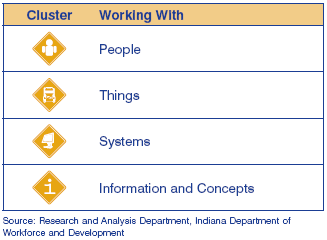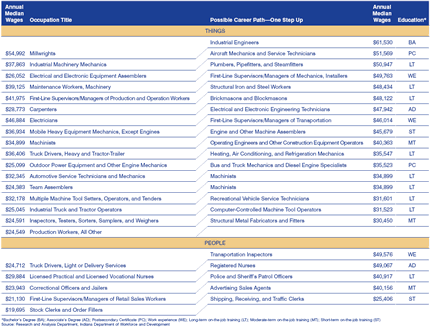Putting Feet on Research: Applying Skill Pathway Analysis to Workforce Development
You've invented the better mousetrap, discovered the cure for the common cold, or developed a different approach to analyzing occupations based on the importance of skills. Now what? One of the challenges researchers face after discovery or development is what to do with the new information or insight. How does it apply to real people?
A new model for career exploration developed by the Indiana Department of Workforce Development (DWD) groups occupations based on required skills and emphasizes the transferability of those skills across seemingly unrelated occupations.
This newly developed model depicts four skill pathways (see Table 1), which are profiled in the recently released “Moving Toward Tomorrow's Jobs: Indiana's New Skill Pathways and Guides.” (1) The career guide can help counselors and job-seekers identify viable career paths and point them to the right education, training and/or work experience. (2)
Table 1: The Four Skill Pathways

Another practical application of this new model are reports that identify the skill sets of workers in transition based on their current occupations and then identify other occupations that value similar skills. This approach allows us to suggest other occupations that are growing in a region for which the workers may qualify without additional training or experience.
One Step Up
DWD regional market analysts produce a quarterly report of Frequently Listed Jobs. These reports highlight job openings and associated wages from all 11 Indiana economic growth regions. These job listings represent actual demand for occupations as requested by area employers using DWD's CS3 job matching tool. Historically, these reports have been dominated by entry-level positions with high turnover—occupations that employers regularly need to fill in large quantities.
DWD's vision is to focus attention on occupations that will pay higher wages and help Hoosiers achieve a better quality of life. To meet employer demand and fill these occupations, we need to encourage education, raise Indiana workers up one level and continue to increase their skills. New job listing reports will continue to include the entry-level positions frequently posted with the job-matching system for each area, but will now include examples of occupations that can take a worker “one step up” in wages with a small amount of additional education, training, skill development or work experience. To assist workers facing layoff situations, custom reports will be developed to highlight a possible career ladder for the dislocated worker. The declining occupation will be matched to occupations that are in demand regionally. A dislocated or underemployed electronic equipment assembler, for example, has developed skills such as equipment selection, troubleshooting and repairing. These are some of the same skills that are vital to a successful career as a plumber or pipefitter. With some on-the-job training or perhaps an apprenticeship, the worker may develop installation and complex problem solving skills to increase their salary by more than $15,000 (based on state median wages).
These “one step up” occupations are chosen only when they have been defined as in demand for Indiana and/or the region in which the layoff is occurring. For an occupation to be considered in demand, it must be projected to show employment growth at or above 10 percent over the next decade, and/or rank high in terms of total job openings (new job growth and replacements) over the next decade. Occupations were limited to those paying greater than $22,038, a salary based on Indiana's Self Sufficiency Standard. (3)
These occupational mappings are being provided to workers at Rapid Response events and job fairs organized by DWD and employers involved in pending layoffs. Rapid Response events are designed to provide early intervention and job services for dislocated workers through collaboration between the State, WorkOne centers, and local workforce boards. (4) The first “one step up” report was recently distributed in conjunction with an upcoming layoff in the automotive sector. Based on an industry-specific staffing pattern, the occupations common to the industry facing the layoff were compared against the frequently listed job postings in that region. The next step involved a review of the skill sets of the auto manufacturing occupations followed by identification of higher wage jobs requiring a similar set of skills. The worker could potentially qualify for these jobs with a small amount of additional training or experience. Obviously, there are many possible matches based on common skill sets plus additional training and/or experience. The “one step up” occupations shown in Table 2 are designed to serve as examples to encourage a more thorough exploration of the possibilities inherent in the transferability of the worker's existing skills and an assessment of those skills.
Table 2: Frequent Job Openings and Possible Career Paths in the Things and People Pathways
The response at these events has been overwhelmingly positive. The new career guide and “one step up” reports are in high demand throughout Indiana. DWD is getting requests from career centers, schools and for use at other dislocation events. Hundreds of guides and reports were distributed at the first informational event and job fair, and thousands more have been ordered for distribution throughout the spring. This information has been placed directly into the hands of workers facing dislocation. Each report is customized by DWD's regional analysts with local information on jobs in demand, required skills and average wages for the featured jobs.
Next Steps
A quarterly “one step up” report will soon be available for each of Indiana's economic growth regions. When appropriate, and as the information is available, DWD analysts will work with local WorkOne centers and Rapid Response teams to provide up-to-date and industry-specific information for workers.
The next stage in development of programs and tools around the skill pathway model will need to include performance measures and analysis of the possible economic impact. If we are able to move 20 dislocated workers up one level from the job listings shown in the left column of Table 2, to the occupations on the right; the average wage of those workers will increase from $31,500 to $42,269. If the skill pathway tools encourage and allow for increased skill development throughout the state, we can hope that Indiana's per capita personal income will grow, bringing a higher quality of life to Indiana workers and closing the income gap between the state and national average. The skill pathway should also open doors for employers as the job applicant pool of skilled workers grows. Job seekers from many different industries can begin to develop the basic skills that have been proven to be vital across a variety of occupations.
For more information, contact the DWD regional analyst in your area. Each regional analyst is listed on the Hoosiers by the Numbers website at www.hoosierdata.in.gov via the “contact us” link.
Notes
- “Moving Toward Tomorrow's Jobs: Indiana's New Skill Pathways and Guides,” InContext (February 2007): 4-5.
- For more information on the new guide check out the Hoosiers by the Numbers website at: www.in.gov/dwd/careerguides/index.html
- A weighted population was used to create a state average, using data from “Refining Measures of Economic Stability: The 2005 Self-Sufficiency Standard for Indiana,” Indiana Business Review (Spring 2006): 5-9.
- The Workforce Investment Act (WIA) designates funds specifically for dislocated workers, and Rapid Response funding is used to provide emergency on-site core services and pre-layoff services as soon as possible. These events typically occur as soon as a Worker Adjustment and Retraining Notification (WARN) notice is issued announcing a mass dislocation or plant closure.
Allison Leeuw and Vicki Seegert, Research and Analysis
Advanced Economic and Market Analysis, Indiana Department of Workforce Development

